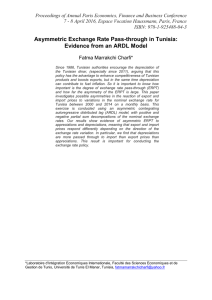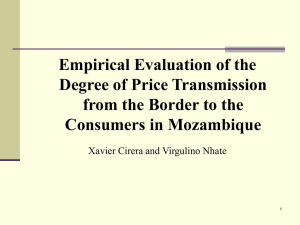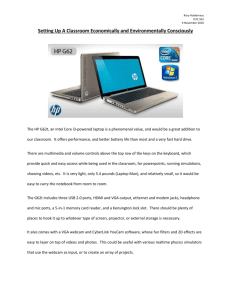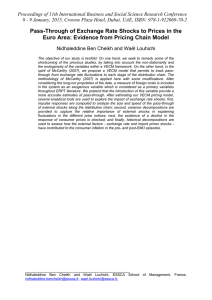Geographical Bilateral Exchange Rate Pass-through in the United States Jon Christensson*
advertisement
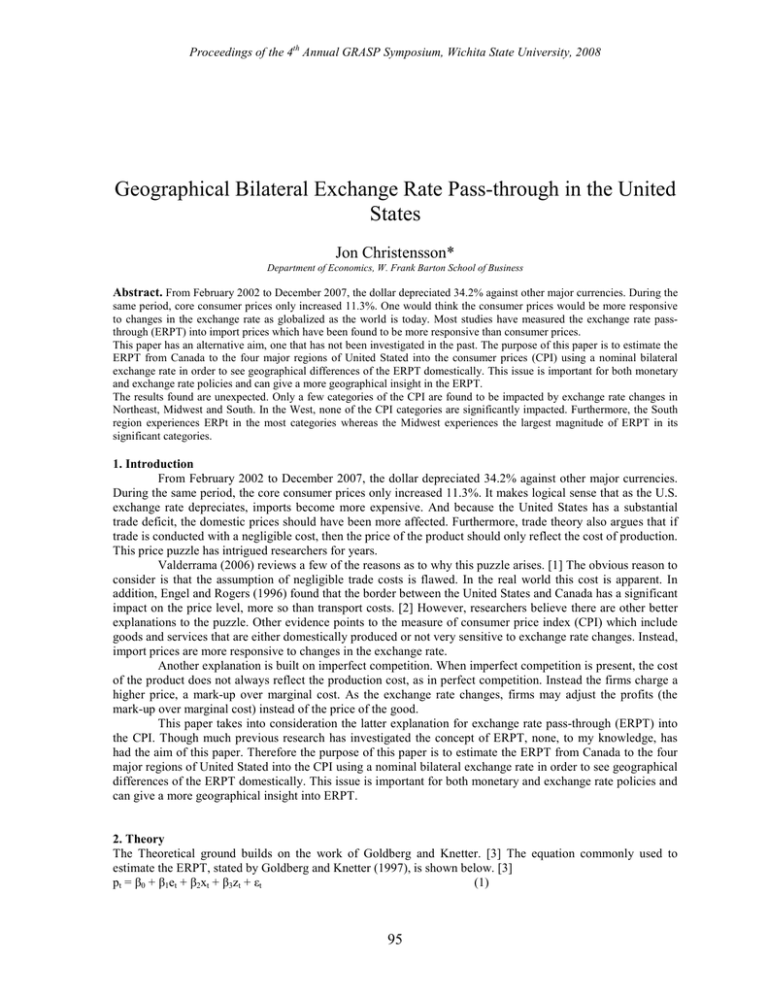
Proceedings of the 4th Annual GRASP Symposium, Wichita State University, 2008 Geographical Bilateral Exchange Rate Pass-through in the United States Jon Christensson* Department of Economics, W. Frank Barton School of Business Abstract. From February 2002 to December 2007, the dollar depreciated 34.2% against other major currencies. During the same period, core consumer prices only increased 11.3%. One would think the consumer prices would be more responsive to changes in the exchange rate as globalized as the world is today. Most studies have measured the exchange rate passthrough (ERPT) into import prices which have been found to be more responsive than consumer prices. This paper has an alternative aim, one that has not been investigated in the past. The purpose of this paper is to estimate the ERPT from Canada to the four major regions of United Stated into the consumer prices (CPI) using a nominal bilateral exchange rate in order to see geographical differences of the ERPT domestically. This issue is important for both monetary and exchange rate policies and can give a more geographical insight in the ERPT. The results found are unexpected. Only a few categories of the CPI are found to be impacted by exchange rate changes in Northeast, Midwest and South. In the West, none of the CPI categories are significantly impacted. Furthermore, the South region experiences ERPt in the most categories whereas the Midwest experiences the largest magnitude of ERPT in its significant categories. 1. Introduction From February 2002 to December 2007, the dollar depreciated 34.2% against other major currencies. During the same period, the core consumer prices only increased 11.3%. It makes logical sense that as the U.S. exchange rate depreciates, imports become more expensive. And because the United States has a substantial trade deficit, the domestic prices should have been more affected. Furthermore, trade theory also argues that if trade is conducted with a negligible cost, then the price of the product should only reflect the cost of production. This price puzzle has intrigued researchers for years. Valderrama (2006) reviews a few of the reasons as to why this puzzle arises. [1] The obvious reason to consider is that the assumption of negligible trade costs is flawed. In the real world this cost is apparent. In addition, Engel and Rogers (1996) found that the border between the United States and Canada has a significant impact on the price level, more so than transport costs. [2] However, researchers believe there are other better explanations to the puzzle. Other evidence points to the measure of consumer price index (CPI) which include goods and services that are either domestically produced or not very sensitive to exchange rate changes. Instead, import prices are more responsive to changes in the exchange rate. Another explanation is built on imperfect competition. When imperfect competition is present, the cost of the product does not always reflect the production cost, as in perfect competition. Instead the firms charge a higher price, a mark-up over marginal cost. As the exchange rate changes, firms may adjust the profits (the mark-up over marginal cost) instead of the price of the good. This paper takes into consideration the latter explanation for exchange rate pass-through (ERPT) into the CPI. Though much previous research has investigated the concept of ERPT, none, to my knowledge, has had the aim of this paper. Therefore the purpose of this paper is to estimate the ERPT from Canada to the four major regions of United Stated into the CPI using a nominal bilateral exchange rate in order to see geographical differences of the ERPT domestically. This issue is important for both monetary and exchange rate policies and can give a more geographical insight into ERPT. 2. Theory The Theoretical ground builds on the work of Goldberg and Knetter. [3] The equation commonly used to estimate the ERPT, stated by Goldberg and Knetter (1997), is shown below. [3] (1) pt = β0 + β1et + β2xt + β3zt + εt 95 Proceedings of the 4th Annual GRASP Symposium, Wichita State University, 2008 All variables are given in logarithm form where pt is the domestic price level at time t, et is the nominal exchange rate at time t, xt is a measure of foreign cost, zt is a control variable, and εt is the error term at time t. This paper uses domestic CPI as the dependent variable. As independent variables, this paper uses a nominal exchange rate, similar to Goldberg and Knetter (1997) and Campa and Goldberg (2005). [3] [4] As a proxy for foreign cost the foreign CPI is used, in accordance with Ganapolsky and Vilan (2005) and Marazzi, Sheets, and Vigfusson (2005). [5] [6] As an additional control variable, to control for the domestic demand, the real personal income is used. This is a similar approach as Campa and Goldberg (2005) who states that “one should include as the appropriate demand variable an index of income levels across the producer’s home market…” ([4] p. 681) Furthermore, due to stationarity issues, the first difference is taken of all variables. 3. Analysis This study is conducted in aggregate as well as in disaggregates level to yield a more precise picture of the ERPT. The various CPI categories are; Core CPI, Food, Shelter, Household furnishing and operations, Apparel, Transportation, Medicare, Energy. The estimation results are presented in Table 1. Table 1. Estimation of the Exchange Rate Pass-Through Core CPI Food Shelter Household Apparel Transportation Medicare Energy North-East Mid-West South West 0.0599 -0.0581 0.0775 -0.0662 -0.1894 0.1777 -0.0195 0.2776 -0.0592 0.0456 -0.0624 -0.1107 -0.1190 0.2621 -0.1030 0.3949 -0.0477 -0.0740 -0.0756 0.1290 -0.0588 0.2129 -0.1100 0.3793 -0.0386 -0.0855 -0.0767 0.1055 -0.2148 0.1376 0.0787 0.2605 The lighter and the darker shade indicate that the CPI series are significantly impacted by the exchange rate at a 10% and a 5% significance level respectively. The results presented are unexpected. One would think that the exchange rate impacted all consumer goods. The results show that only a selected amount of categories are impacted. Take the category energy in Northeast as an example. As the growth rate of exchange rate increases by 1%, the growth rate of the energy cost increases by 0.28%, ceteris paribus. The region experiencing the highest ERPT is the south, which is the only region that does not directly border Canada. This result deviates from the findings of Campa and Goldberg (2005) who states that border regions are in general more sensitive to exchange rate changes. [4] Though the South experiences the most ERPT in categories, the Midwest ERPT has the greatest magnitude. Interestingly, the West region does not experience any ERPT in any category. A possible explanation as to this may be some difference in market structure, for example taxation on fossil fuel use. Finally, monetary policy can influence the exchange rate through the interest rate. These results can therefore give the Federal Reserve an insight as to how their monetary policy affect domestic consumer prices in the different regions. 3. Conclusion The purpose of this paper was to estimate the ERPT from Canada to the four major regions of United Stated into the CPI using a nominal bilateral exchange rate in order to see geographical differences of the ERPT domestically. The findings presented were unexpected. The only region not directly bordering Canada, South, had ERPT in most categories, whereas the Midwest had the highest magnitude of the ERPT. Furthermore, the West region experienced no ERPT at all. A possible explanation to this may be some market structure difference. However, further research on this area is needed. [1] Valderrama, D. (2006). The Exchange Rate – Consumer Price Puzzle. FRBSF Economic Letter. 2006-23, pp. 1-3. [2] Engel, C., & Rogers, J. (1996). How wide is the Border?. American Economic Review. 86(5), pp. 1112-1125. [3] Goldman, P.K., & Knetter, M.M. (1997). Goods Prices and Exchange Rates: What have we learned?. Journal of Economic Literature. 35(3), pp. 1243-1272. [4] Campa, J.M., & Goldberg, L.S. (2005). Exchange Rate Pass-through into Import Prices. The Review of Economics and Statistics. 87(4), pp. 679-690. [5] Ganapolsky, E.J., & Vilán, D. (2005). Buy Foreign While You Can: The Cheap Dollar and Exchange Rate Pass-Through. Federal Reserve Bank of Atlanta, Economic Review. Third Quarter, 2005. pp. 15-36. [6] Materazzi, M., Sheets, N., & Vigfusson, R.J. (2005). Exchange Rate Pass-through to U.S. Import Prices: Some New Evidence. Board of Governors of the Federal Reserve System, International Finance Discussion Paper. No. 833. 96
